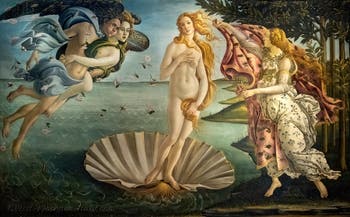Uffizi Artists | Location | Opening Hours Tickets | Authorizations
Artists Botticelli | Michelangelo | Da Vinci | Caravaggio | Raphael | Titian | Giorgione | Medici | Dürer Cranach Memling | Credi Bartolomeo | Rubens
Botticelli Spring | Venus | Pallas | Calumny | Judith | Augustine | Young Man | Magi Novella | Magi (1500) | Annunciation Cestello | Annunciation Martino | Madonna Pomegranate | Coronation Virgin | Madonna Magnificat | Madonna Enthroned | Madonna Glory | Madonna Rose | Madonna Saints
“The Birth of Venus” by Sandro Botticelli at the Uffizi Gallery in Florence
Tempera on Canvas (175,5 x 278,5 cm) 1484
The Birth of Venus In a seascape, Venus, naked and standing in a large scallop shell, is pushed towards the shore by the winds Zephyr and Aura (personification of the breeze), gently intertwined under a sky from which roses rain.
A young girl, one of the horae (daughters of Zeus and Themis), dressed in a flower dress with a belt of roses, wears her a silk coat decorated with daisies and other flowers.
The true theme of Botticelli's painting is the birth of “Humanitas”, the essence of man, human nature, generated by its four elements and the union of mind with matter.
So Venus's nudity has nothing to do here with a pagan vision of female beauty.

The Birth of Venus Its nudity means purity, simplicity, nude beauty of the soul.
Entwined lovers, Zephyr and Aura, represent the breath of passion by which the barely born goddess Venus is pushed and inspired.
Eros interpreted as the active ingredient of love.
The roses falling from the sky thanks to the fruitful breath of love winds find their complement in the flowery mantle stretched by the young horae in Venus to protect her nudity.
A nudity that is both sensual and chaste, the double nature of love.
Botticelli's message then becomes clear: to show the convergence and concomitant presence of the opposites of the transient nature of the human person, body and soul.
Botticelli Spring | Venus | Pallas | Calumny | Judith | Augustine | Young Man | Magi Novella | Magi (1500) | Annunciation Cestello | Annunciation Martino | Madonna Pomegranate | Coronation Virgin | Madonna Magnificat | Madonna Enthroned | Madonna Glory | Madonna Rose | Madonna Saints
Artists Botticelli | Michelangelo | Da Vinci | Caravaggio | Raphael | Titian | Giorgione | Medici | Dürer Cranach Memling | Credi Bartolomeo | Rubens
Uffizi Artists | Location | Opening Hours Tickets | Authorizations
Back to Top of Page













